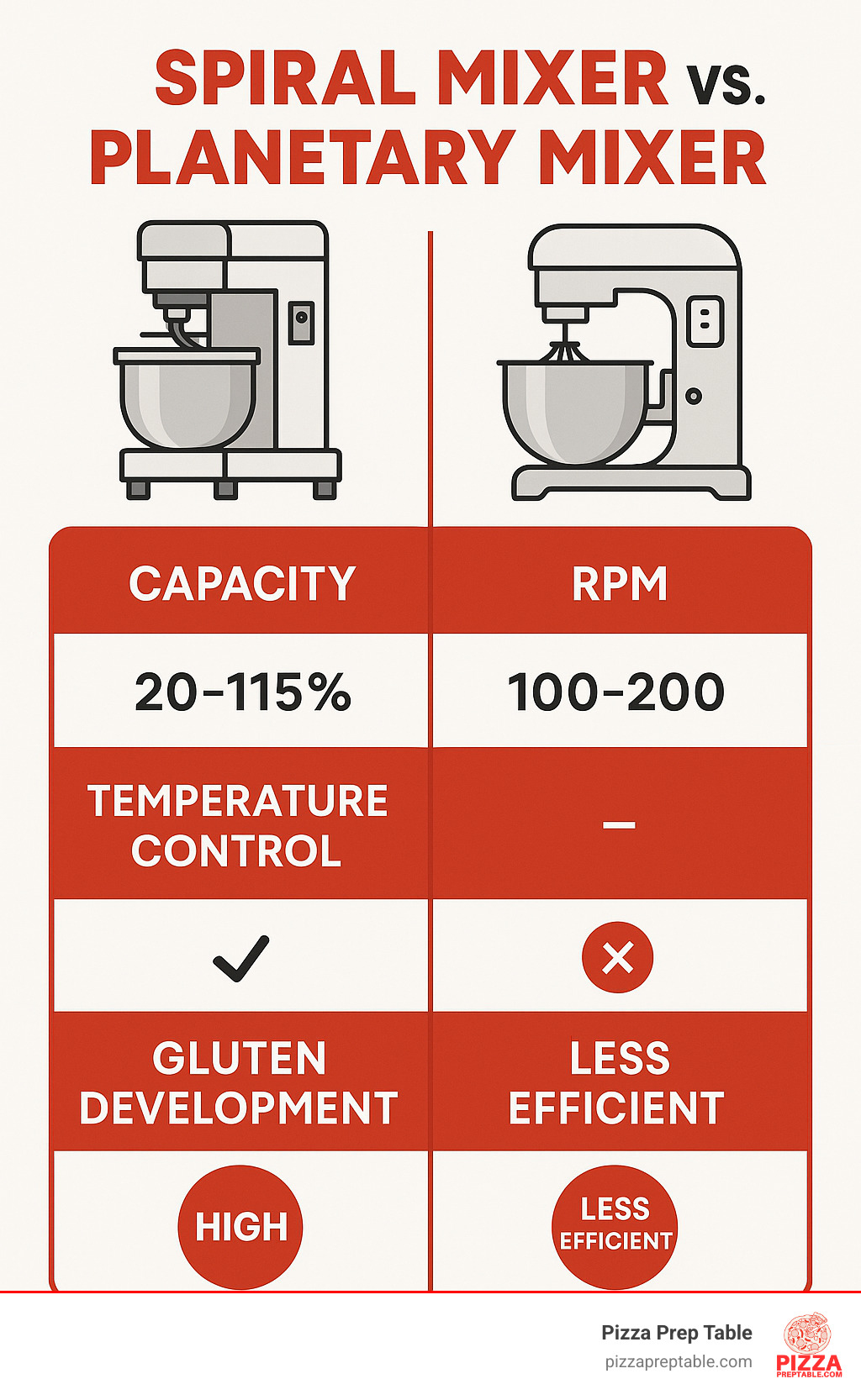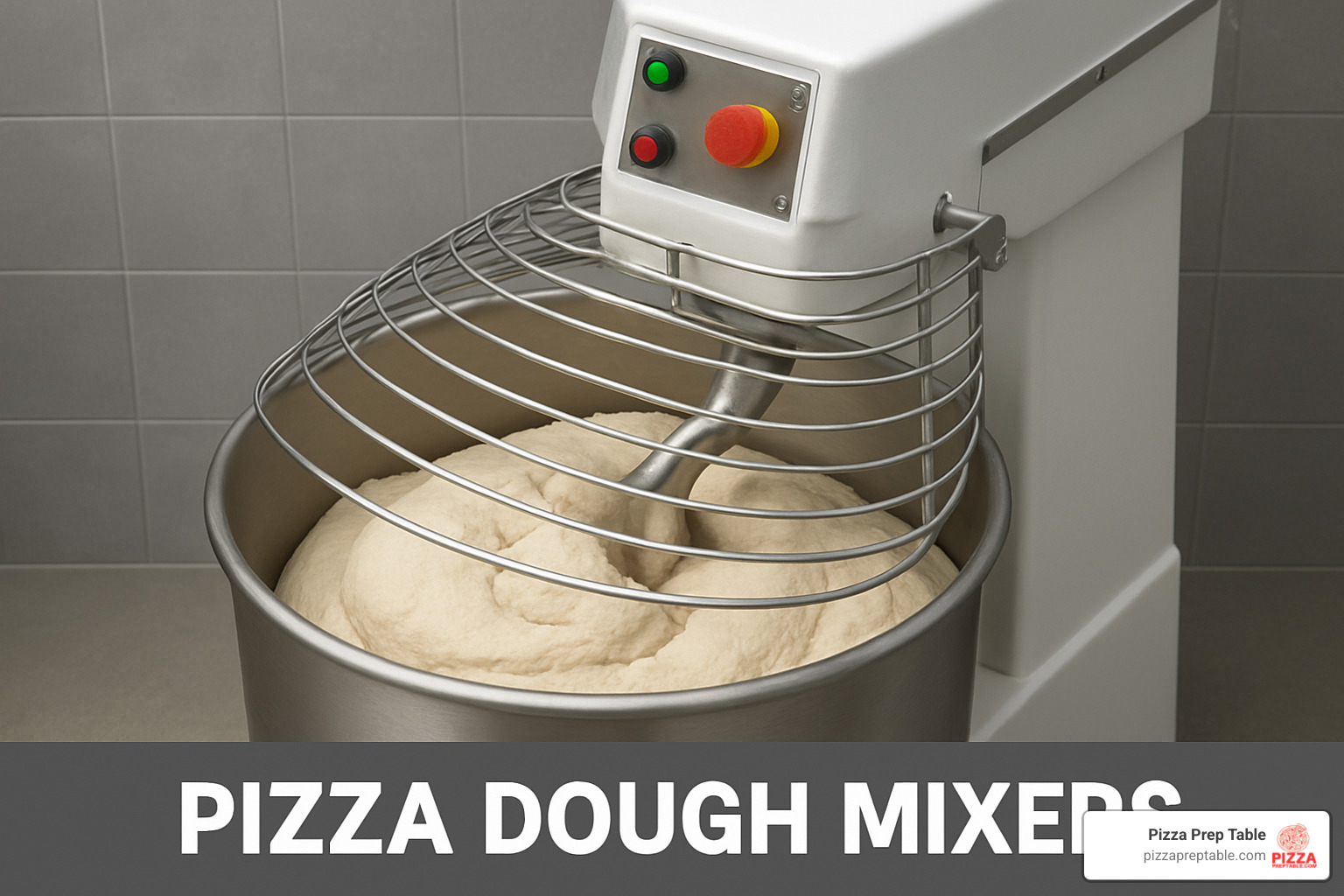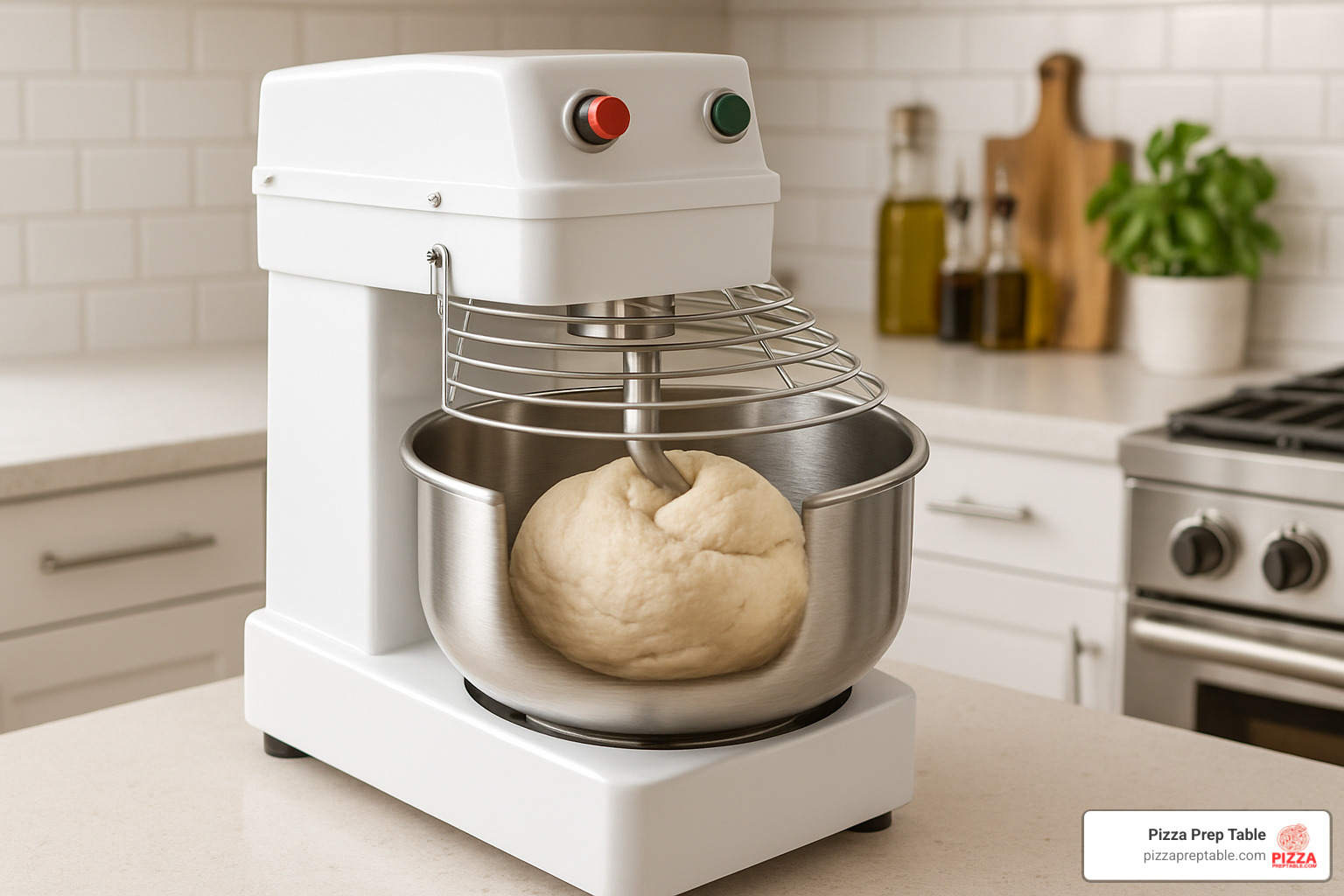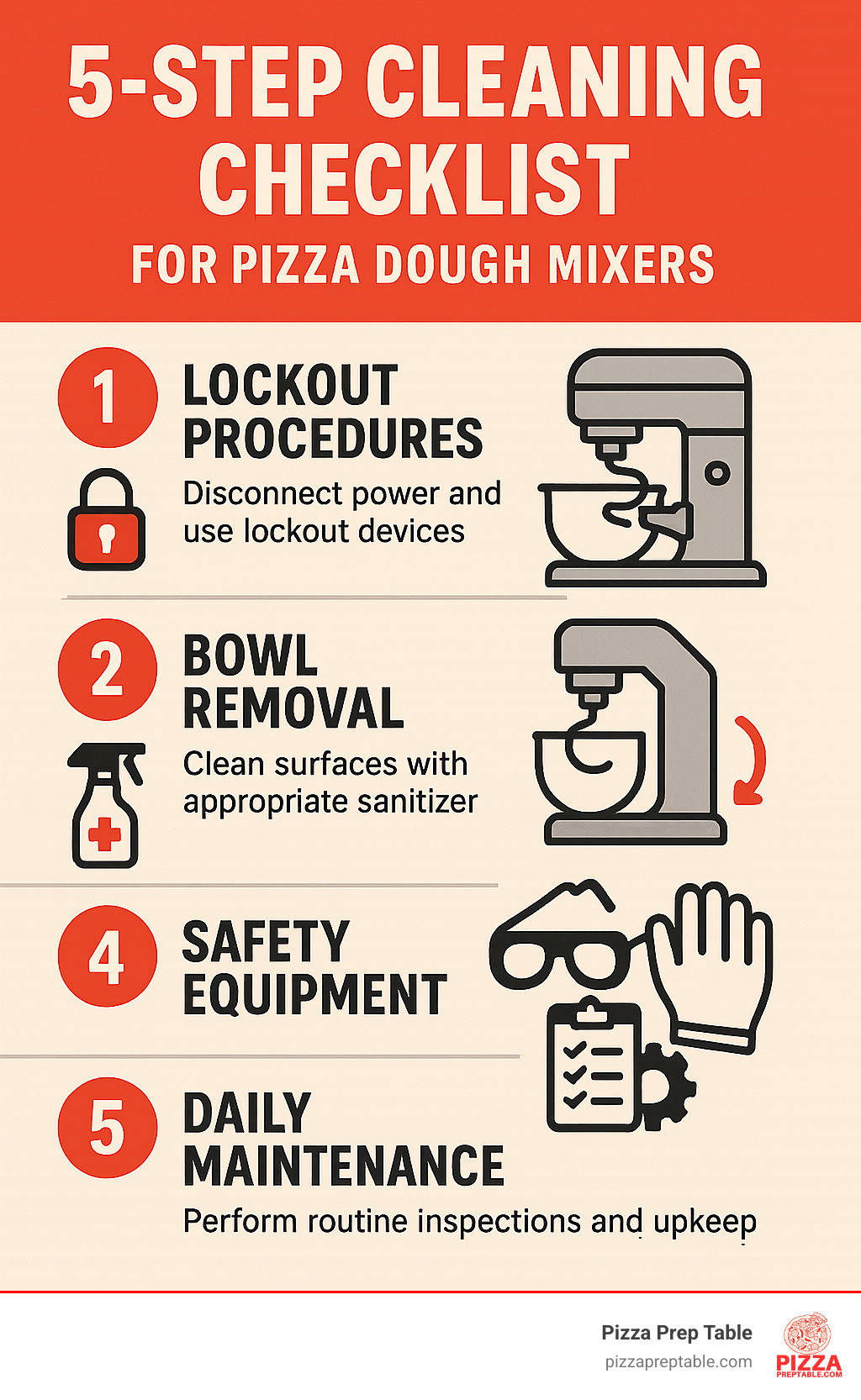
The Ultimate Guide to Choosing the Best Pizza Dough Mixers
Share
Why Pizza Dough Mixers Are Essential for Consistent, Quality Dough
Pizza dough mixers are specialized machines designed to knead and develop gluten in pizza dough more efficiently than hand mixing. Here are the main types and their key benefits:
Top Pizza Dough Mixer Types:
- Spiral Mixers - Best for pizza dough, 30% more efficient gluten development, operates at 100-200 RPM
- Planetary Mixers - Versatile but less efficient, good for small batches and multiple attachments
- Fork Mixers - Gentle folding action, ideal for high-hydration doughs up to 70%
- Diving Arm Mixers - Mimics hand kneading, premium option for artisanal results
Key Benefits: - Cut mixing time by up to 50% compared to traditional methods - Maintain low dough temperature (only 1-2°C increase during mixing) - Handle capacity ranges from 20% to 115% of maximum bowl capacity - Deliver consistent gluten development for uniform texture
Whether you're running a busy pizzeria or perfecting dough at home, the right mixer saves time and delivers better results than hand kneading.
The science behind great pizza dough lies in proper gluten development without excessive heat buildup. Pizza dough mixers achieve this through controlled mixing speeds and specialized bowl movements that fold and stretch the dough rather than overworking it.
I'm Sean Kearney, and my background in sales and deep understanding of foodservice equipment needs has given me extensive experience helping restaurants choose the right pizza dough mixers for their operations.

Essential pizza dough mixers terms: - best stand mixer for pizza dough - kneading pizza dough in stand mixer
Understanding Pizza Dough Mixers: Types, Motion & Science
If you've ever wondered why professional pizzerias produce consistently perfect dough while your kitchen counter looks like a flour bomb exploded, the answer often comes down to the right pizza dough mixers. Understanding how different mixer types work is the key to choosing equipment that transforms your dough-making from guesswork into science.
The magic happens in how each mixer develops gluten while keeping friction heat under 2°C. Different mixing motions create vastly different results:
| Mixer Type | RPM Range | Bowl Action | Best For | Heat Generation |
|---|---|---|---|---|
| Spiral | 100-200 | Rotating | Pizza dough | Very low |
| Planetary | 56-99 | Stationary | Multi-purpose | Moderate |
| Fork | ~80 | Rotating | High-hydration | Very low |
| Diving Arm | 35-80 | Stationary | Artisan dough | Minimal |
Spiral Mixers – The Gold Standard for Pizza Dough
Spiral mixers dominate professional pizza kitchens for good reason. Their design is neatly simple: a stationary spiral hook stays put while the bowl rotates around it, creating gentle folding motion that develops gluten without aggressive beating.
Spiral mixers develop gluten roughly 30% more efficiently than planetary mixers, meaning stronger dough in less time. Most operate at two speeds – typically 100 RPM for combining ingredients and 200 RPM for gluten development.
What sets spiral mixers apart is incredible capacity flexibility, handling dough loads from 20% to 115% of maximum capacity. Compare that to most stand mixers, which need at least 75% capacity just to function properly.
The science behind their effectiveness lies in partial kneading. The spiral hook only works portions of the dough at any moment, minimizing friction heat while maximizing gluten development.
For deeper insights into effective kneading techniques, our guide on mixing and kneading pizza dough covers the technical details.
Planetary Mixers vs Pizza Dough Mixers: Pros, Cons & Best Uses
Planetary mixers take a different approach. The mixing attachment orbits around a stationary bowl while spinning on its own axis – like a planet around the sun. This creates thorough mixing, but it's less efficient for dough development.
The versatility advantage of planetary mixers is undeniable. With attachment hubs accepting everything from meat grinders to vegetable slicers, they're the Swiss Army knives of commercial kitchen equipment. Commercial models like the Hobart Legacy+ offer shift-on-the-fly speed controls.
However, planetary mixers generate higher dough temperatures due to increased friction and offer limited capacity flexibility compared to spiral mixers.
The Hobart Legacy+ HL662 represents the pinnacle of commercial planetary mixing, capable of handling up to 90 pounds of thick pizza dough in a single batch. Its PLUS System combines variable frequency drive technology with reinforced components.
For home users, most consumer stand mixers aren't engineered for regular pizza dough production. The KitchenAid speed guidance recommends speed 2 for dough mixing to prevent motor strain.
Our comprehensive guide to Industrial Planetary Mixers That Are Out of This World breaks down professional equipment features.
Fork & Diving Arm Pizza Dough Mixers Explained
At the artisanal end of pizza dough mixers, fork and diving arm mixers prioritize gentle handling over speed. These machines are the choice of traditional pizzerias valuing dough quality above production volume.
Fork mixers use a specialized fork-shaped tool rotating slowly – typically under 80 RPM – to fold dough rather than beat it. This folding action incorporates oxygen while maintaining low temperatures, creating superior texture and flavor development. They excel with high-hydration doughs up to 70% water content.
Diving arm mixers take the artisanal approach further, operating between 35-80 RPM with a diving motion that mimics human hand kneading. This creates what enthusiasts describe as "more flavorful dough that maintains a human touch."
Both mixer types offer superior temperature control, keeping dough cool throughout mixing. This is crucial for maintaining yeast activity and preventing tough, overworked texture.
For detailed specifications, the FC60 Fork Mixer documentation provides comprehensive technical information.
How to Choose the Right Mixer for Your Kitchen
Choosing the perfect pizza dough mixer comes down to understanding your specific needs and matching them to the right machine. The most important rule is the 80% capacity guideline: your mixer's usable dough weight is roughly 80% of its bowl volume in liters.
Start by honestly assessing your batch size requirements. A home baker making two pizzas weekly has vastly different needs than a pizzeria cranking out 200 pies daily.
Space constraints often surprise people. Measure twice, buy once – including doorways, ceiling height, and workspace around the mixer.
Power requirements can make or break your decision. Most home kitchens run on single-phase 110V power, while heavy-duty commercial mixers need three-phase 220V.
Budget considerations span from $300 countertop models to $30,000 commercial powerhouses. The sweet spot for most small businesses falls between $1,500 and $5,000.
For detailed guidance on sizing decisions, check out our guide: How to Choose a Large Mixer That Fits Your Kitchen and Your Needs.
Key Features Checklist for Pizza Dough Mixers
Certain features separate the workhorses from the wannabes in pizza dough mixers.
Safety features should be non-negotiable. Every quality mixer needs an emergency stop button and bowl guard with safety interlock. Commercial models often include triple interlock systems.
Variable speed control gives flexibility to combine ingredients gently, then develop gluten at higher speeds. A timer with auto-stop prevents over-mixing, while removable bowl design makes cleaning easier.
Build quality indicators include NSF sanitation certification and UL electrical safety approval. Stainless steel construction resists corrosion, while ball bearing assemblies ensure smooth operation.
The Hobart Legacy+ series exemplifies these features with its MagnaLock triple interlock system and Shift-on-the-Fly controls.
Our Whip It Good: The Ultimate Professional Mixer Buying Guide covers everything in detail.
Matching Mixer to Hydration, Flour & Recipe Needs
Different pizza dough mixers handle varying hydration levels with dramatically different results.
Hydration compatibility varies significantly by mixer type. Stand mixers typically struggle with stiff, low-hydration doughs below 58%, but excel with higher hydration doughs up to 70%. Spiral mixers offer the most flexibility, efficiently handling 50% to 80% hydration. Fork mixers shine with high-hydration artisan doughs between 60% and 75%.
Flour protein content also influences mixer choice. High-protein flours (12-14% protein) need more intensive mixing, favoring spiral mixers. Lower protein flours (10-12% protein) respond well to gentler fork or diving arm mixers.
Temperature management remains critical. Target maintaining dough temperature around 24°C (75°F) after mixing to prevent gluten damage and maintain proper fermentation timing.
For technical specifications on professional spiral mixers, the IM60 Spiral Mixer documentation provides detailed capacity and performance data.
Best Pizza Dough Mixers of 2024: Product Roundup

Finding the perfect pizza dough mixer can feel overwhelming with so many options available. After years of helping pizzerias choose equipment and testing dozens of models ourselves, we've narrowed down the field to the machines that truly deliver exceptional results.
Our top picks span the full spectrum - from affordable $300 home units that transform weekend pizza nights to $30,000 commercial powerhouses that handle hundreds of pounds of dough daily. What they all share is reliability, consistent performance, and the ability to produce superior dough quality compared to hand mixing.
The sweet spot for most operations lies between these extremes. Whether you're opening your first pizzeria or upgrading from an overworked stand mixer, there's a machine here that will transform your dough production without breaking the bank.
Commercial Heavy-Hitters: Top Spiral & Planetary Pizza Dough Mixers
When volume and consistency matter most, these commercial pizza dough mixers represent the absolute best in their class. Each has earned its reputation through years of reliable service in demanding commercial kitchens.
The Hobart Legacy+ HL662 stands as the undisputed champion at $27,250. This 60-quart planetary mixer handles up to 90 pounds of pizza dough per batch - enough for most busy pizzerias' entire day's production. Its PLUS System technology delivers 30% more mixing capacity through variable frequency drive technology and reinforced components. The triple interlock safety system and dishwasher-safe bowl guard make it as safe as it is powerful.
What sets the HL662 apart is its two-speed operation at 56 and 99 RPM, allowing gentle ingredient incorporation followed by proper gluten development. At 955 pounds and requiring 240V three-phase power, it's a serious commitment - but one that pays dividends in consistency and durability.
For spiral mixer enthusiasts, the Estella SM40 offers exceptional value at $8,500. This 40-quart spiral mixer handles 5.5 to 35 pounds of flour and up to 60 pounds of finished dough with remarkable efficiency. The hook operates at 112-198 RPM while the bowl rotates at 15-20 RPM, creating the perfect folding action that spiral mixers are famous for.
The American Eagle AE-75K rounds out our commercial recommendations at $12,800. This 75-quart spiral mixer brings belt-driven reliability to high-volume operations. Its quiet operation makes it ideal for open kitchens where noise matters as much as performance.
You can find detailed specifications and comparisons in our Planetary or Spiral Sell Sheet for a deeper dive into these commercial workhorses.
Home & Small Biz Favorites – Compact Pizza Dough Mixers

The home and small business market offers some genuinely exciting options that bring professional mixing capabilities to compact kitchens. These pizza dough mixers prove you don't need massive equipment to achieve consistently excellent results.
The Autentico 700 Spiral Mixer at $1,200 represents a breakthrough for serious home bakers. This compact spiral mixer delivers professional-grade mixing in a countertop footprint. Customer reviews consistently rave about the dramatic improvement in dough quality. As one enthusiastic user put it: "So easy to use! Definitely takes my at-home pizza to the next level."
For small pizzerias or ambitious home operations, the ilFornino MED 21 QT at $2,800 hits the sweet spot between capacity and affordability. This 21-quart spiral mixer operates at 150 RPM with 750 watts of power, handling serious dough loads while fitting through standard doorways. The emergency stop and bowl guard safety features bring commercial-grade protection to smaller operations.
The Bosch Universal Plus at $400 takes a different approach entirely. While not a spiral mixer, its unique drive system and plastic bowl excel at pizza dough mixing. It handles up to 4 pounds of flour efficiently and takes up minimal counter space - perfect for kitchens where every inch matters.
At the entry level, the KitchenAid Pro 600 at $350 remains the most accessible option for home bakers. However, success requires understanding its limitations. Use only speed 2 for pizza dough, limit batch sizes to prevent motor strain, and follow the manufacturer's guidance carefully. It's not ideal for daily commercial use, but it opens the door to better dough for occasional bakers.
For comprehensive guidance on choosing the right home mixer, check out our detailed guide: Knead to Know Basis: Choosing the Best Stand Mixer for Pizza Dough.
Using, Maintaining & Troubleshooting Your Pizza Dough Mixer

Getting the most from your pizza dough mixer isn't just about pushing the start button. Proper technique and maintenance make the difference between mediocre dough and consistently excellent results.
Most pizza doughs need between 4-15 minutes of total mixing time, but exact timing depends on your recipe and mixer type. Temperature monitoring is critical – keep final dough temperature around 24°C (75°F).
The autolyse technique works wonders. Mix flour and water first, then rest for 20-30 minutes before adding salt and yeast. This pre-hydration reduces overall mixing time and improves final texture.
Bassinage – gradually adding water during mixing – helps achieve higher hydration levels without overworking the dough.
Pizza Dough Mixers Setup & Daily Workflow
Creating a bulletproof daily routine eliminates most operational problems. Start each shift by inspecting safety guards and emergency stops. Check that bowl and hook show no signs of damage.
Your ingredient loading order matters: always add flour first, then water, finally salt and yeast. This prevents clumping and ensures even distribution.
Speed progression is crucial. Start on low speed for 1-2 minutes to combine ingredients, then increase to working speed for gluten development.
The 30-minute timer on most commercial mixers protects against overmixing. Set it every time, even for short batches.
For detailed operational guidance, check out Rise to the Occasion with These Pizza Dough Kneading Machines.
Cleaning & Safety Best Practices for Pizza Dough Mixers

Proper cleaning protects your investment. A well-maintained pizza dough mixer can run reliably for decades.
Lockout/tagout procedures aren't optional in commercial kitchens. Disconnect power before any cleaning or maintenance work.
Most commercial mixers have dishwasher-safe bowl guards and removable components. Remove the bowl, hook, and guards for thorough sanitizing.
Bowl removal systems vary by manufacturer. Learn the proper technique for your specific model – spiral mixer bowls can be heavy and awkward.
The cleaning schedule should include daily sanitizing of food contact surfaces and weekly deep cleaning of drive mechanisms. Check lubrication requirements.
Staff PPE requirements include cut-resistant gloves, safety glasses when using chemicals, and non-slip shoes. Document training and keep records current.
Weekly maintenance should include checking belt tension, inspecting electrical connections, and documenting unusual noises or vibrations.
Frequently Asked Questions about Pizza Dough Mixers
Can I make great pizza dough without a mixer?
You absolutely can make fantastic pizza dough by hand! Many pizza masters swear by hand kneading, especially for small batches. There's something deeply satisfying about feeling the dough transform under your hands as the gluten develops.
Hand kneading shines when you're making dough for just a few pizzas. You get complete control over the process, can feel exactly when the gluten is properly developed, and there's zero heat generation from friction. Plus, you can't beat the equipment cost - your hands are free!
The secret to successful hand kneading is the autolyse technique. Mix your flour and water first, then let it rest for 20-30 minutes before adding salt and starting the actual kneading. This rest period lets the flour hydrate naturally, which cuts your actual kneading time in half.
Hand kneading works best for lower hydration doughs under 65% and when you're not in a rush. If you're making pizza for the family on Sunday afternoon, hand kneading can actually give you better results than a basic stand mixer that might overheat your dough.
What size pizza dough mixer do I need?
Getting the right size pizza dough mixer is crucial - too small and you'll be frustrated, too big and you'll waste money and counter space. The golden rule is the 80% capacity guideline: your mixer's practical capacity is about 80% of its stated bowl volume.
For home pizza nights, a 5-7 quart mixer handles family-sized batches perfectly. If you're running a small café making fresh pizza daily, you'll want to step up to a 20-30 quart unit. Busy pizzerias typically need 40-60 quart mixers to keep up with demand, while high-volume operations require 80+ quart commercial units.
Here's where it gets tricky: hydration levels affect capacity significantly. A 60 quart mixer might handle 90 pounds of low-hydration dough but only 60 pounds of high-hydration dough. The wetter your dough, the less your mixer can handle per batch.
Always plan for growth when sizing your mixer. It's much better to have slightly more capacity than you need today than to outgrow your mixer in six months. Trust me - I've seen too many pizzeria owners wish they'd gone one size larger from the start.
How much should I budget for a quality pizza dough mixer?
Pizza dough mixer pricing spans a huge range, from a few hundred dollars to tens of thousands. The good news is there's quality equipment at every price point.
For home use, budget $300-$1,500 depending on your needs. A KitchenAid Pro 600 at $350 gets you started, while the Autentico 700 at $1,200 brings professional spiral mixing to your home kitchen. The Bosch Universal Plus at $400 offers excellent value for serious home bakers.
Light commercial operations should plan for $1,500-$5,000. The ilFornino 21 quart at $2,800 represents the sweet spot for small pizzerias, offering professional features without breaking the bank.
Heavy-duty commercial mixers range from $6,000-$30,000. The Estella SM40 at $8,500 handles mid-volume operations beautifully, while the legendary Hobart HL662 at $27,250 represents the ultimate in commercial mixing power.
Don't forget about hidden costs when budgeting. Larger mixers need three-phase electrical installation, which can add $500-$2,000 to your project. Factor in delivery, setup, and training too. Many suppliers offer financing options that can help spread the cost over time, making professional equipment more accessible for growing businesses.
Conclusion
Finding the perfect pizza dough mixer isn't just about buying equipment - it's about changing how you make pizza. Whether you're kneading dough for family pizza night or cranking out hundreds of pies daily, the right mixer changes everything about your process and results.
After helping countless pizzerias and home bakers choose their mixers, we've seen the same pattern over and over: spiral mixers dominate commercial kitchens because they simply work better. That 30% more efficient gluten development isn't marketing speak - it's the difference between good dough and great dough. The superior temperature control means your dough stays cool and manageable, even during busy rushes.
For home kitchens, compact spiral mixers like the Autentico 700 bring that same professional quality to your countertop. You can still make excellent pizza with a traditional stand mixer (just remember the speed 2 rule for KitchenAid users!), but once you experience spiral mixing, it's hard to go back.
The secret to choosing wisely comes down to honest self-assessment. How much dough do you really make? How often? What's your actual budget when you factor in installation and electrical requirements? A $30,000 Hobart might be impressive, but a $1,200 compact spiral could be exactly what your operation needs.
Don't overlook the basics that separate successful mixer owners from frustrated ones: proper training, regular maintenance, and strict safety protocols. The fanciest mixer in the world won't help if your staff doesn't know how to use it safely or your maintenance schedule gets ignored.
At PizzaPrepTable.com, we've built our reputation by understanding that choosing commercial kitchen equipment isn't just about specs and prices - it's about finding solutions that actually work for real kitchens and real budgets. Whether you're in New York, Los Angeles, Chicago, or anywhere in between, we're here to help you make equipment decisions that support your success, not strain your resources.
Ready to upgrade your dough game? Browse our complete selection of pizza dough mixers and get the expert guidance you need to choose the perfect model. Your future pizza-loving customers (or family members) will thank you for it.
For more insights on pizza equipment and techniques, check out our comprehensive resource: More info about pizza equipment.
